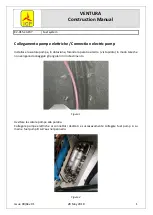
SECTION 4
CESSNA
NORMAL PROCEDURES
MODEL 172RG
Full power runups over loose gravel are especially harmful to pro-
peller tips. When takeoffs must be made over a gravel surface, it is very
important that the throttle be advanced slowly. This allows the airplane to
start rolling before high RPM is developed, and the gravel will be blown
back of the propeller rather than pulled into it. When unavoidable small
dents appear in the propeller blades they should be corrected immediately
as described in Section 8 under Propeller Care.
After full power is applied, adjust the throttle friction lock clockwise to
prevent the throttle from creeping from a maximum power position.
Similar friction lock adjustment should be made as required in other flight
conditions to maintain a fixed throttle setting.
WING FLAP SETTINGS
Normal and short field takeoffs are accomplished with wing flaps 0°.
To clear an obstacle, an obstacle clearance speed of 63 KIAS should be
used.
Soft field takeoffs are performed by lifting the airplane off the ground
as soon as practical in a slightly tail-low attitude. If no obstacles are ahead,
the airplane should be leveled off immediately to accelerate to a safer
climb speed.
At takeoff weights of 2550 pounds or less, 10° flaps may be used if
desired for minimum ground runs or takeoffs from soft or rough fields.
CROSSWIND TAKEOFF
Takeoffs into strong crosswinds normally are performed with the
minimum flap setting necessary for the field length, to minimize the drift
angle immediately after takeoff. With the ailerons partially deflected into
the wind, the airplane is accelerated to a speed slightly higher than
normal, and then pulled off abruptly to prevent possible settling back to
the runway while drifting. When clear of the ground, make a coordinated
turn into the wind to correct for drift.
LANDING GEAR RETRACTION
Landing gear retraction normally is started after reaching the point
over the runway where a wheels-down, forced landing on that runway
would become impractical. Since the landing gear swings downward
approximately two feet as it starts the retraction cycle, damage can result
by retracting it before obtaining at least that much ground clearance.
4-16
1 July 1979
CESSNA
SECTION 4
MODEL 172RG
NORMAL PROCEDURES
Before retracting the landing gear, the brakes should be applied
momentarily to stop wheel rotation. Centrifugal force caused by the
rapidly-spinning wheel expands the diameter of the tire. If there is an
accumulation of mud or ice in the wheel wells, the rotating wheel may rub
as it is retracted into the wheel well.
EN ROUTE CLIMB
Normal climbs are performed at 85-95 KIAS with flaps up, 25 In. Hg. or
full throttle (whichever is less) and 2500 RPM for the best combination of
engine cooling, rate of climb and forward visibility. If it is necessary to
climb rapidly to clear mountains or reach favorable winds at high
altitudes, the best rate-of-climb speed should be used with maximum
power. This speed is 84 KIAS at sea level, decreasing to 77 KIAS at 10,000
feet.
If an obstruction ahead requires a steep climb angle, a best
angle-of-climbspeed should be used with landing gear and flaps up and maximum
power. This speed is 67 KIAS at sea level, increasing to 68 KIAS at 10,000
feet.
The mixture should be full rich during climb at altitudes up to 3000 feet.
Above 3000 feet, the mixture may be leaned for increased power and
smooth engine operation. With the optional Cessna Economy Mixture
Indicator, the mixture may be leaned to maintain the EGT indication
corresponding to full rich at 3000 feet. Without an EGT indicator, the
mixture may be leaned to momentary engine roughness and then enri-
chened two full turns at the mixture control knob. Each of these procedures
result in approximately the same mixture and will significantly improve
high altitude climb performance.
CRUISE
Normal cruising is performed between 55% and 75% power. The
corresponding power settings and fuel consumption for various altitudes
can be determined by using your Cessna Power Computer or the data in
Section 5.
NOTE
Cruising should be done at a minimum of 75% power until
a total of 25 hours has accumulated or oil consumption has
stabilized. Operation at this higher power will ensure
1 July 1979
4-17














































